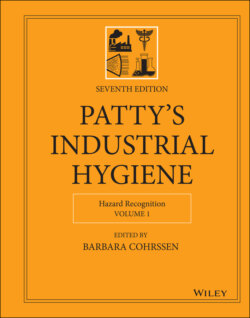Читать книгу Patty's Industrial Hygiene, Hazard Recognition - Группа авторов - Страница 23
2.8 1990s: Growth of Industrial Hygiene Management
ОглавлениеIn the 1990s, sophisticated industrial employers began to see industrial hygiene programs as an investment to keep their workers more productive. The purpose of an industrial hygiene program was and is to ensure a healthful workplace for employees. An effective program should include all the functions needed to anticipate, recognize, evaluate, and control health hazards to workers associated with production, office, and other work, as well as any related risk for family members or the community. This requires a comprehensive program designed around the nature of the operations, documented to preserve a sound retrospective record, and executed in a professional manner. An integrated program is capable of responding to the need for the establishment of appropriate exposure controls, both for current needs and for those that may result from technological advances and associated process changes.
The almost universal availability of high‐capacity and powerful desktop computers in the 1990s greatly facilitated the management of industrial hygiene programs. An abundance of industrial hygiene‐related software for record keeping, technical reference (e.g. regulations and safety data sheets [SDSs]), sampling data analysis, exhaust ventilation design, and other such industrial hygiene functions became available from commercial sources, or through professional journals, professional associations, and individual industrial hygienists. The AIHA began a Computer Applications Committee, whose mission it is to provide a forum for advancing the use of computer applications by occupational and environmental health professionals.
The science and profession of industrial hygiene became generally recognized as having an important role in industry. It was recognized generally in the 1990s that the industrial hygienist at the corporate or equivalent level should report to top management. His/her responsibility involves appropriate input whenever product, technological, operational, or process changes, or other corporate considerations may have an influence on the nature and extent of associated health hazards. When new plants or processes are under consideration, the corporate industrial hygienist should ensure that adequate controls are incorporated at the design stage. In the 1990s, the profession almost doubled again with the number of CIHs rising from 4581 at the end of the 1980s to 7966 by the end of the 1990s.
Elsewhere in 1995, The International Occupational Hygiene Association (IOHA) hosted an international workshop on certification in Blackpool, the United Kingdom. The goals of the workshop were to further the development and application of occupational hygiene and to enhance movement of occupational hygiene professionals across national borders. To prepare for the workshop, IOHA published an inventory of existing certification/licensing schemes for occupational hygienists in Canada, Italy, Japan, The Netherlands, the United Kingdom, and the United States (53).
